Fungal Leaf Spots: Commonly found on the foliage of many plants, fungal leaf spots are largely cosmetic diseases. Most do not interfere with the normal growth & development of the plant. Therefore, within the landscape, fungicides are not normally recommended. Years that have relatively dry spring weather will experience fewer leaf spot infections.
Many fungal leaf spot infections will demonstrate typical symptoms. Surrounding the initial infected spot will be alternating light-dark-colored concentric rings. The darker areas contain plant-defensive chemicals that the plant uses in an attempt to compartmentalize the invading fungus. If the fungus is virulent enough it may have the ability to move past the barrier & infect the tissue outside of it. The plant will respond again & form a new barrier surrounding the infected area. Sometimes these light-dark discolorations can continue until a target appearance forms. Many times, black fruiting bodies can be seen within the center of the light-colored bull’s eye site where the infection originated.
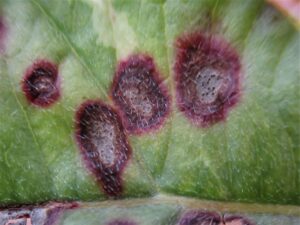
A dark colored halo will often surround the central fungus infection site. The black fruiting bodies can be observed within the central tan area. (Photo Credit: Steven K. Rettke, Rutgers Coop. Ext.)
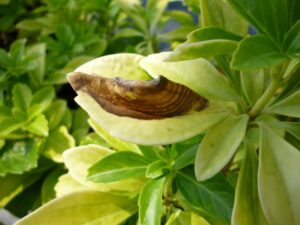
Alternating light-dark colored concentric rings. The dark rings are composed of plant defensive chemicals the plant uses in the attempt to wall-off the invading fungus. (Photo Credit: Steven K. Rettke, Rutgers Coop. Ext.)
The Landscape Pest Notes Blog for Early May 2023 is listed below & is composed of some commonly observed insect/mite & disease pests occurring within landscape & nursery plants. The insect/mite pests included are andromeda lace bug, lilac borer, boxwood leafminer, spruce spider mite, & horned/gouty oak galls. The disease pathogen pests included in addition to fungal leaf spots are black knot, sycamore anthracnose, Diplodia tip blight, & apple scab fungus.
Andromeda Lace Bugs (Stephanitis takeyai) (192-303 GDD =1st gen treatment): Foliar symptoms caused by this familiar landscape pest will become apparent during the month of May on the new leaves of previously infested Andromeda shrubs. This host-specific pest overwinters as eggs that are inserted into the lower leaf veins. The other common lace bug species with evergreen hosts also over-winter as eggs (e.g., Azalea & Rhododendron lace bugs). Alternatively, lace bugs with deciduous hosts over-winter as adults (e.g., oak & hawthorn lace bugs). Adult lace bugs that over-winter as eggs have oval-shaped wings with rounded corners (Stephanitis genus). On the other hand, adult lace bugs with deciduous hosts have rectangular-shaped wings with squared-off wing corners (Corythucha genus). Most of our landscape lace bug species have three or more generations per year.
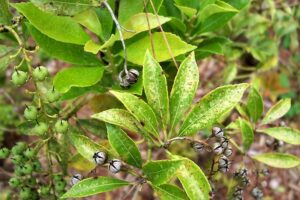
The stippling symptoms on the andromeda leaves are readily apparent. The Andromeda Lace Bugs will always be found feeding underneath the leaves. (Photo Credit: Steven K. Rettke, Rutgers Coop. Ext.)
For future consideration, it is useful to remember that the eggs of Andromeda lace bugs typically hatch at least a week or two earlier than the other evergreen host species (i.e., ~200 vs. 350 GDD). Attempts to control eggs with dormant horticultural oils are futile since most of the eggs are not exposed. However, with good coverage, horticultural oils can successfully suppress lace bug nymphs and adults to a lesser degree. Insecticidal soaps are exceptionally fast-acting insecticides and can also be highly effective if proper coverage is achieved. If infestations of the Andromeda lace bug or any of the other species become a perennial problem, then Merit (imidacloprid) may be the product of choice. Field studies and observations have shown that soil injections of this material can maintain effective controls for at least 1 or 2 years. Therefore, applying Merit every year as a preventative is probably unnecessary. After October of 2023, the neonicotinoids will no longer be labeled for use within NJ residential landscapes.
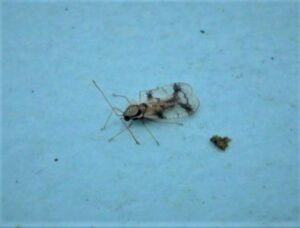
Andromeda Lace Bugs are within the genus Stephanitis & feed on broadleaf evergreens & overwinter as eggs. Lace bug species in this genus have oval shaped wings with rounded corners. (Photo Credit: Steven K. Rettke, Rutgers Coop. Ext.)

Hawthorn Lace Bugs are within the genus Corythucha & feed on deciduous hosts & overwinter as adults. Lace bugs species within this genus contain wings that are rectangular with squared-off corners. (Photo Credit: Steven K. Rettke, Rutgers Coop. Ext.)
Lilac Borer (Podosesia syringae) (148-299 GDD =adult emergence): This clearwing moth borer is active now or will soon be in most areas of NJ. Look for wilting and dieback of branches, bark cracking, and exit holes in large stems. Pheromone traps are excellent to monitor for the presence of this pest. Once the first male moth is captured (one-inch-long wasp-like adult with brownish black front wings/body and pointed tail), wait a week then apply a residual insecticide to the stems. Note that the lilac borer prefers to lay eggs on older trunks/stems. A spray of permethrin (Astro), a pyrethroid on the bark now will kill and prevent new larvae from tunneling within the bark. The goal is to have the pyrethroid insecticide applied to the bark before the eggs hatch.
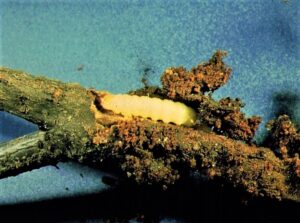
Lilac Borers are clearwing moth caterpillars that have 5 or fewer pairs of prolegs. (Photo Credit: Ohio State Univ. Coop. Ext.)
Cultural controls involve pruning out any stem larger than two inches in diameter. If there are many such trunks/stems, plan on a three-year pruning schedule to remove them all & therefore encourage younger shoots to establish. This type of pruning increases the flowering of the lilac and so has several benefits (including non-chemical control). Lilac borer may also attack ash trees if any are still around. Beneficial nematodes should also control larvae (~50%?) once they are in the bark this summer.
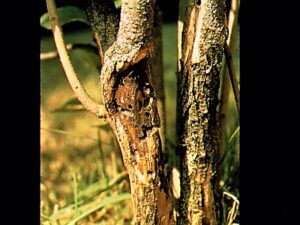
A cultural practice to reduce potential Lilac Borer infestations is to avoid wounding stems & to remove older, less vigorous stems greater than 2 inches in diameter. (Photo Credit: Deborah Smith-Fiola, Former Rutgers Coop. Ext. Ag. Agent)
Boxwood Leafminer (Monarthropalpus flavus) (~249+ GDD =active adults): Adults of this imported pest are orange-yellow mosquito-like flies about 1/8 inch in size. They can be seen swarming around boxwoods for two weeks during mid-May (~249+ GDD)(shake bushes to detect flying adults). Yellowish, blister-like blotch mines on the undersurface of leaves are caused by larvae feeding inside the leaves of American boxwood. Heavily mined foliage turns yellow and drops prematurely. Damage to new season growth does not become readily apparent until the fall since the heaviest feeding is done in the fall and late winter months. When egg-laying adults are seen, contact insecticides can provide good suppression. If numerous mines are found during the summer and fall, a systemic spray, acephate (Orthene), or imidacloprid (Merit) can be applied to kill larvae within the mines. The overwintering larvae are also susceptible to these controls during the late winter-feeding period. After October of 2023, the neonicotinoids will no longer be labeled for use within NJ residential landscapes. Avid and Talstar are also labeled. Replace susceptible plants with resistant cultivars.
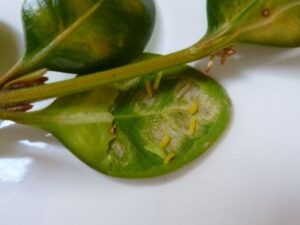
Boxwood Leafminer larvae will soon pupate & emerge as adults in mid-May in central NJ. (Photo Credit: Steven K. Rettke, Rutgers Coop. Ext.)
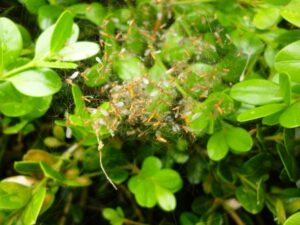
Boxwood Leafminer adults were captured in a spiders prepared webbing that anticipated their emergence. (Photo Credit: Steven K. Rettke, Rutgers Coop. Ext.)
Spruce Spider Mites (Oligonychus ununguis) (7-121 GDD =overwintering eggs hatch): These tiny mites thrive in cool spring weather and have been active for more than a month. Damage often does not become noticeable (bronzing, obvious stippling) until plants are stressed with hot weather and when this occurs it is typically too late to do much. They will continue to feed on spruce, arborvitae, and other conifers until temperatures settle regularly into the mid to upper 80s, after which they will lay eggs that will not hatch until the fall. Spraying is only recommended if damage exceeds 10% of foliage or if 15-20 active mites are tapped (on average) from branches onto a beating tray. Use your hand lens to look for the small round eggs. During the spring months, they can produce 4-5 generations.
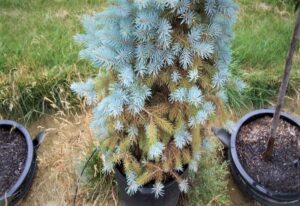
Spruce Spider Mites are a cool season mite species. This Colorado blue spruce clearly shows the older, inner needles with spruce spider mite stippling symptoms. The mites entered summer dormancy & the new, outer needle growth received little feeding damage. (Photo Credit: Steven K. Rettke, Rutgers Coop. Ext.)
Plan on a horticultural oil application (1-2%) (not on blue spruce) or Hexygon, both of which will kill eggs. Apply to plants damaged by these pests last season This will destroy some of the active mites as well as the over-wintering mite eggs that have not yet hatched. Be careful to closely monitor for mites during the weeks ahead, since where they were a problem in the past, they will likely be a problem again (the oil application will not give 100% control). Floramite, Avid, Talstar, Delta Gard, insecticidal soap, and Scimitar are some other miticide options. Non-ovicidal miticides often require more than a single application. Keep in mind that Orthene will only suppress mites.
Gouty Oak Gall (Callirhytis quercuspunctata) & Horned Oak Gall (Callirhytis cornigera) (~270 GDD =adult emergence): These woody galls are up to 2 inches in diameter and are formed on branches of many oaks. Large galls may girdle branches and cause significant dieback. They are caused by female wasps emerging from old galls in late May. They lay eggs in oak leaves and the hatched larvae feed and cause a blister-like gall to form along the leaf vein. In July, adults emerge again and lay eggs in twigs. The familiar woody galls will grow on these twigs over a period of 2 to 3 years.
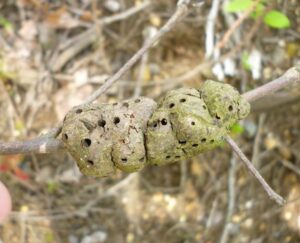
The adult Gouty Oak Gall wasps emerge through exit holes after more than 2 years growth. (Photo Credit: Steven K. Rettke, Rutgers Coop. Ext.)
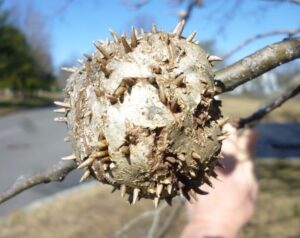
The adult Horned Oak Gall wasps emerge through spikes after more than 2 years growth. (Photo Credit: Steven K. Rettke, Rutgers Coop. Ext.)
Although pruning out galls is the only recommended control, realistically it is not highly effective since it is hard to get rid of all the over-wintering galls in the area. Contact insecticides will kill emerging adults (~270 GDD), yet timing and coverage are difficult, so overall control is minimal. Since most wasp attacks are at the tips of trees, leaf expansion makes it difficult to provide an effective pesticide residue. Multiple spray applications over two years have shown some success, but the exact timing is necessary. Trunk injections using both Avid and Bidren at oak bud leaf expansion have provided controls of greater than 95%. Note that when control is less than 95%, high pest levels usually reoccur. Trunk injections of imidacloprid (Merit) have shown suppression levels of only 50% or less. All the trunk injection materials listed above were applied at oak bud leaf swell. After October of 2023, none of the neonicotinoids will be labeled within NJ residential landscapes.
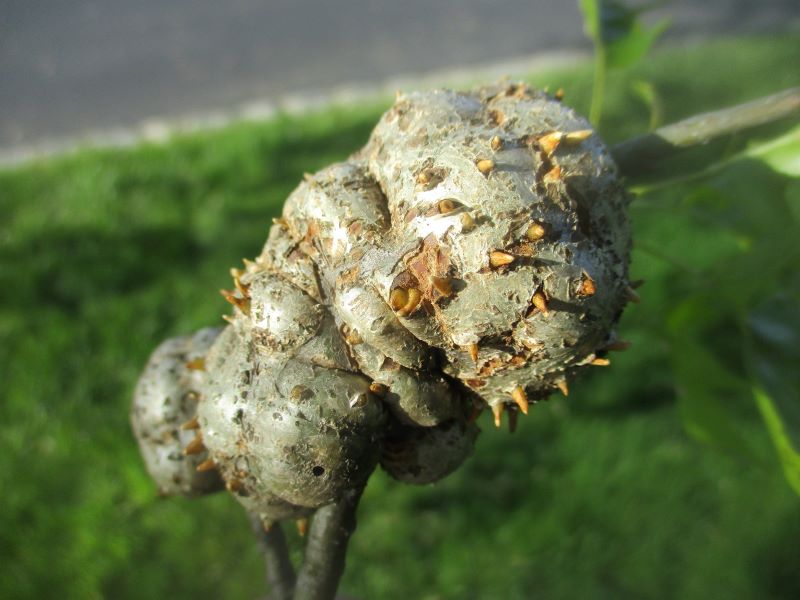
Horned oak gall & early wasp emergence of adult female wasps. Early emergence begins in May at 270 GDD. (Photo Credit: Steven K. Rettke, Rutgers Coop. Ext.)
Black Knot (Apiosporina morbosa): Black knot of Prunus is caused by the native fungal pathogen Apiosporina morbosa. Prunus spp. (especially plum & cherry) are susceptible to this fungal canker disease. Infections create black galls that can encircle twigs & stems causing dieback & distortion of branches. The swelling of infected stems is often visible during the fall season after infection during the spring. The hard, elongated “knot” develops on branches during the second summer of the following year.
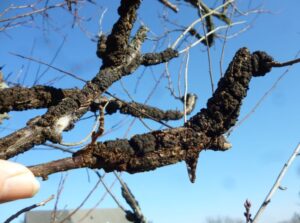
Black Knot fungus galls have girdled & killed stems after numerous years of growth. (Photo Credit: Steven K. Rettke, Rutgers Coop. Ext.)
Early the next spring (1 year after infection) the surface of the gall swelling turns a light-green coloration & releases spores during the rainy spring weather. (The gall develops a black coloration by the end of summer in the 2nd year.) These spores can infect wounded stems or newly emerging green shoots. If not removed, the gall can continue to release infecting spores for over a decade. The gall can continue to grow & elongate within the woody stem by infecting adjacent tissues. If the branch dies, then the spore production will no longer occur.
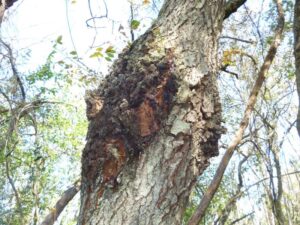
Although less commonly observed, Blank Knot fungus can also infect & grow within the main stem of tree. This will ultimately result in the death of the tree if the trunk is girdled. (Phot Credit: Steven K. Rettke, Rutgers Coop. Ext.)
Pruning out knots or swollen branches at least 3-4 inches below affected areas & removing them off-site is the best method to suppress this disease. Applying fungicides during the period of active shoot elongation in the spring can provide protection but will be of limited value if the cultural procedures cannot be done.
Sycamore Anthracnose (Apiognomonia): A common disease of American sycamore trees. The London plane tree cultivars have some resistance. Twigs & branches may die back if the infection is severe, or the tree is in poor health. Similar to other leaf spot diseases, sycamore anthracnose is more severe when the weather is cool (60°-65°F.) & moisture remains on leaf surfaces for extended periods. Mild winters also will provide for higher disease incidences.
During the winter, sunken cankers can be seen in living or dead branches. Branch ends can also be observed having a witches-broom growth proliferation. This crooked branch pattern occurs when bud death initiates new & close adjacent bud formations.
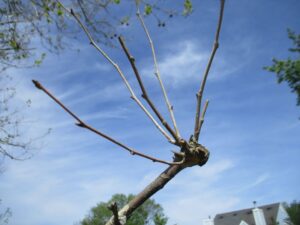
During the winter season, it is easier to observe the crooked branch formations & witches-broom symptoms created after many years of Sycamore Anthracnose infections. (Photo Credit: Steven K. Rettke, Rutgers Coop. Ext.)
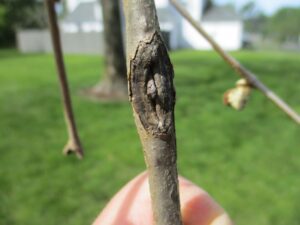
Sycamore Anthracnose stem cankers can grow & release infecting spores over multiple years. Mild winters will enhance development. (Photo Credit: Steven K, Rettke, Rutgers Coop. Ext.)
Diseased leaves appear scorched along veins & leaf margins, especially on lower & inner branches. Sensitive American sycamore trees often have extensive defoliation during mid-spring. Often, by late spring the only leaves remaining will be at the upper crown. However, by mid-summer, the trees will normally completely regain their leaf canopy. Typically, infected sycamores can live for many decades with this disease.
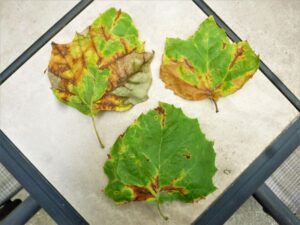
Sycamore Anthracnose leaf infections will typically accumulate along major leaf veins. (Photo Credit: Steven K. Rettke, Rutgers Coop. Ext.)
Since sycamore anthracnose does not usually cause serious damage to healthy trees, applying fungicides is recommended only when necessary to highly valued trees. Trees located in a key location can be injected with a fungicide in the fall season before leaves drop. This protects newly expanding leaf tissue the following spring. Improve plant vigor, prune dead branches (~4 inches below branch cankers), & avoid planting highly sensitive trees. Therefore, plant resistant cultivars that have been vegetatively propagated from ‘Bloodgood’, ‘Columbia’, or ‘Liberty’ clones of London plane trees.
Diplodia Tip Blight (Diplodia pinea): A fungus disease in the landscape commonly observed on Austrian pines (Pinus nigra), but can also be found infecting mugo, red, black, & Scots pines. The symptoms of Diplodia Tip Blight are stunted or dead shoots. With extensive infections, almost every branch & twig can be affected as the disease spreads over the years. The lower branches of the Austrian pines are usually infected first. For numerous years, the upper canopy will initially show few symptoms. The cones of afflicted pines become infected by this fungus & the spores produced will “rain down” during the weeks of spring to infect the lower branches. The fungus will then kill developing needles in the spring, resulting in dead candles that are deformed & much shorter than the growth found on healthy twigs.
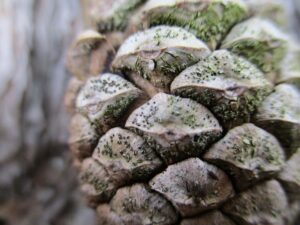
Diplodia Tip Blight fungus black fruiting bodies on infected pine cone scales. The spores will “rain down” to infect newly emerging needles. (Photo Credit: Steven K. Rettke, Rutgers Coop. Ext.)
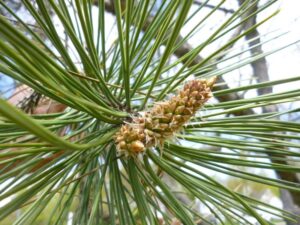
Diplodia Tip Blight & the critical period to apply an effective fungicide treatment. The new spring twig bud has begun to grow, but the pine needles have yet to extend. (Photo Credit: Steven K. Rettke, Rutgers Coop. Ext.)
When management of Diplodia Tip Blight is attempted with fungicide treatments, then it is crucial to have the sprays applied during or shortly before the critical period when the new buds are just beginning to emerge & break from their sheaths. When well-timed fungicides are applied, then this disease can be successfully managed. A fungicide that has shown to be effective is Cleary 3336 & sprays need to be applied until run-off. When spraying any conifer with fungicides the addition of a spreader-sticker is typically required. A 2nd & possibly a 3rd application is then recommended at 10-14-day intervals. However, if the 1st application is missed during the crucial stage, then any later applications will be far less effective.
Apple Scab Fungus (Venturia inaequalis): Many of the newer varieties of Malus are resistant to this disease. Apple scab is caused by the fungus Venturia inaequalis, which overwinters in fallen diseased leaves from the previous season. This fungus also has multiple generations during the spring months & can continue to produce new infecting spores. The new leaves of crabapple are infected as they emerge in late April or early May. Lesions often become evident during late May or early June.
The initial symptoms appear on the leaves as olive-green smudgy spots with feathery margins & range in size up to ½-inch in diameter. The spots often concentrate along the main leaf veins & can occur on either side of the leaf. The fungus is capable of forcefully ejecting spores into the air with special structures it develops in the old leaf tissues. Wind currents carry the spores through the air to settle on young leaves & fruit during the spring. It only requires light rain during a warm spring night to produce severe infection to susceptible Malus varieties.
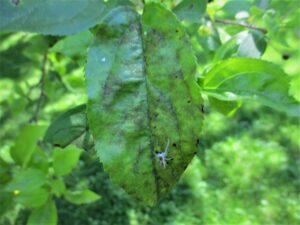
An infected Malus leaf showing symptoms from Apple Scab fungus. (Photo Credit: Steven K. Rettke, Rutgers Coop. Ext.)
Complete suppression of apple scab disease is not usually practical in the landscape. Usually, the aesthetic appearance of the tree is still satisfactory if less than 30% of the tree defoliates from the infection. However, to prevent major defoliation of crabapple in a key location, a few well-timed fungicide treatments can help. Systemic fungicides, such as Cleary 3336 (plus a spreader sticker) provide some residual capabilities. The first application should be applied before flowering occurs. The second treatment needs to be sprayed no more than 3 weeks later. After 3 weeks, the residual effectiveness of the fungicide wears off. Since fungal spore dispersal may continue for at least six weeks in the spring, the two treatments can give partial suppression. During wet springs, the above strategy may prove unsuccessful, but with moderately dry conditions the two well-timed applications can provide satisfactory protection.

